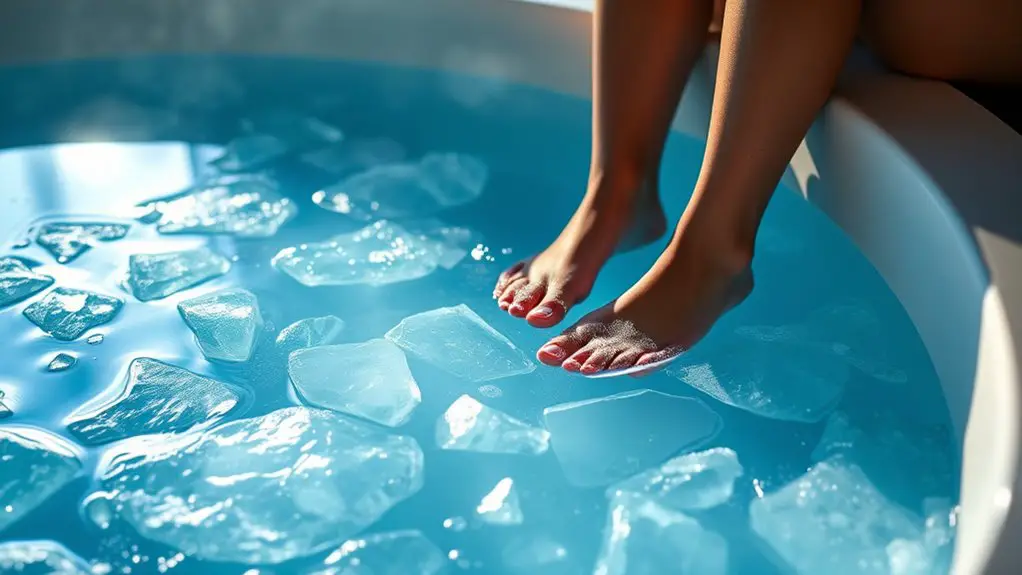Cold exposure can enhance your athletic endurance by boosting muscle efficiency and promoting mental resilience. When you engage in cold training, your body adapts by improving blood flow and oxygen delivery to muscles, which helps to combat fatigue. Plus, it conditions your mind to push through discomfort. However, you need to be aware of safety measures and risks. There's much more to discover about the advantages and techniques of cold exposure for athletic performance.
Understanding Cold Exposure and Its Mechanisms
When you consider cold exposure, it's essential to understand how it affects your body during athletic activities. Cold can trigger a series of responses that might enhance or hinder your performance. Your body prioritizes maintaining its core temperature, redirecting blood flow to important organs. This can lead to reduced circulation in your extremities, making your hands and feet feel numb. As you push through the chill, your muscles may tighten, limiting mobility and stamina. However, embracing cold exposure can also build resilience, pushing your mental limits and fostering a sense of freedom. Just remember, balance is key; too much cold can be detrimental. Learning to navigate this chill can open new doors in your athletic journey, allowing you to thrive in diverse environments.
Physiological Responses to Cold Weather
Cold exposure triggers a range of physiological responses that greatly impact athletic performance. When you venture into chilly conditions, your body ramps up heat production, increases heart rate, and redirects blood flow to essential organs. It's a beautiful dance of adaptation, allowing you to push your limits.
| Response | Effect on Performance | Tips for Athletes |
|---|---|---|
| Increased metabolism | Higher energy expenditure | Layer clothing for warmth |
| Vasoconstriction | Preserves core temperature | Warm-up thoroughly |
| Elevated heart rate | Boosts oxygen delivery | Stay hydrated |
Understanding these responses helps you embrace the cold, rather than shy away. So, gear up, trust your body, and enjoy the invigorating freedom of cold-weather workouts!
The Science Behind Cold Exposure and Muscle Performance
While you might think that frigid temperatures hinder muscle performance, recent research suggests that cold exposure can actually enhance certain aspects of athletic ability. When you're exposed to cold, your body activates a range of physiological responses that can lead to improved muscle efficiency. Cold can boost your blood flow, allowing for better oxygen delivery to your muscles. It may also trigger adaptations that increase your muscle's resilience to fatigue. Plus, training in cooler conditions can enhance your mental toughness, pushing you to embrace discomfort. So, rather than shying away from the chill, consider it a tool to reveal your potential. Embracing cold exposure might just give you the edge you need to elevate your performance and achieve your athletic goals.
Benefits of Cold Exposure for Endurance Athletes
Athletes often seek ways to push their limits, and cold exposure can play a significant role in enhancing endurance performance. By incorporating cold exposure into your routine, you may experience improved circulation and reduced muscle soreness, allowing for more effective training sessions. This adaptation can help your body utilize oxygen more efficiently, boosting your stamina during long workouts. Cold exposure also triggers the release of certain hormones, like norepinephrine, which can enhance focus and mental clarity—critical components for endurance athletes. Additionally, it may increase your body's tolerance to fatigue, giving you the edge you need to outperform your competitors. Embracing the chill could be the key to revealing your true potential and achieving new personal bests.
Risks and Challenges of Training in Cold Conditions
Training in cold conditions can pose significant risks, especially if you're not properly prepared. Hypothermia is a real threat, and it can sneak up on you when temperatures drop. Your body loses heat faster than you might think, leaving you vulnerable to fatigue and poor performance. Frostbite is another danger, particularly for exposed skin, which can lead to serious injury. Plus, icy surfaces can increase the risk of falls, making your workout more hazardous. It's important to listen to your body; shivering or numbness signals it's time to head indoors. Embracing the freedom of outdoor training is exhilarating, but being aware of these challenges helps you stay safe while chasing those goals. So, gear up wisely!
Techniques for Safe Cold Exposure
When facing the risks of cold exposure, knowing how to train safely can make a significant difference in your performance and well-being. Embracing the chill doesn't mean sacrificing safety; here are some techniques to help you thrive:
- Layer Up: Wear moisture-wicking base layers to keep warm and dry.
- Warm Up Properly: Spend extra time on dynamic stretches to get your blood flowing.
- Stay Hydrated: Drink plenty of fluids, as hydration is essential even in cold conditions.
- Listen to Your Body: Pay attention to signs of hypothermia or frostbite; don't push through discomfort.
- Set Time Limits: Start with shorter sessions and gradually increase exposure as you adapt.
Cold Water Immersion vs. Cold Air Exposure
Cold water immersion and cold air exposure both offer unique benefits for enhancing athletic endurance, but they affect the body in different ways. When you plunge into cold water, the immediate shock can boost your circulation and reduce inflammation. This rapid cooling can help your muscles recover faster, allowing you to train harder and longer. On the other hand, cold air exposure tends to stimulate your body's metabolic processes without the intense shock of water. It can enhance your mental resilience and improve your overall stamina. Choosing between the two depends on your personal preferences and training goals. Embrace the freedom to experiment with both methods and discover what works best for you, revealing your full athletic potential.
Case Studies: Athletes Who Utilize Cold Exposure
Many elite athletes have turned to cold exposure as a key component of their training regimens, showcasing its effectiveness through various case studies. You might find it inspiring to learn how these athletes harness cold exposure to elevate their performance:
- A marathon runner uses ice baths post-race to reduce inflammation and speed recovery.
- A professional cyclist incorporates cold showers, enhancing endurance during long rides.
- A triathlete practices cold water swimming to adapt to lower temperatures.
- A football player employs cryotherapy sessions to reduce muscle soreness after intense workouts.
- An Olympic swimmer integrates cold exposure in their routine, improving mental resilience.
These examples underline how embracing cold can unveil your potential and push your limits, transforming your approach to endurance training.
Practical Tips for Incorporating Cold Exposure Into Training
As you look to enhance your training regimen, incorporating cold exposure can be a game-changer for your endurance. Start by integrating cold showers into your daily routine. They're an easy way to acclimate your body. Next, consider ice baths after intense workouts to aid recovery. Finally, try outdoor runs in cooler temperatures. Here's a quick guide to help you:
| Method | Frequency |
|---|---|
| Cold Showers | Daily |
| Ice Baths | Post-workout, 2-3 times a week |
| Outdoor Runs | Once a week in cooler weather |
Embrace the chill and let it elevate your performance. You'll find that cold exposure not only builds endurance but also invigorates your spirit, allowing you the freedom to push your limits.
Frequently Asked Questions
How Does Cold Exposure Affect Recovery Times After Intense Workouts?
Cold exposure can speed up recovery times after intense workouts by reducing inflammation and muscle soreness. It helps you feel rejuvenated, allowing you to tackle your next exercise session with renewed energy and less discomfort.
Can Cold Exposure Enhance Mental Toughness in Athletes?
Cold exposure can definitely enhance your mental toughness. It challenges your comfort zones, pushing you to endure discomfort. Over time, this builds resilience and helps you stay focused, even when facing tough situations in your training.
What Are the Long-Term Effects of Regular Cold Exposure on Endurance?
Imagine your endurance soaring like a rocket as you embrace regular cold exposure. You'll likely experience improved circulation, enhanced recovery, and mental resilience, releasing a newfound freedom in your athletic journey and pushing your limits further.
Are There Specific Types of Clothing Recommended for Cold Training?
For cold training, you'll want moisture-wicking layers, thermal insulators, and windproof outerwear. Don't forget gloves and a hat to keep extremities warm. Staying dry and insulated lets you embrace the freedom of the outdoors!
How Does Individual Tolerance to Cold Vary Among Athletes?
Did you know about 50% of athletes struggle with cold tolerance? Your individual response to cold varies due to factors like body fat, training level, and genetics. Embrace your uniqueness; it's part of your athletic journey!




